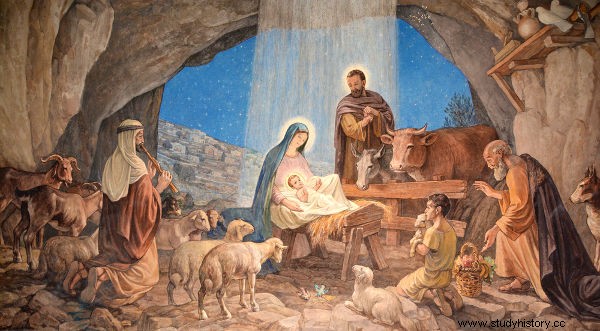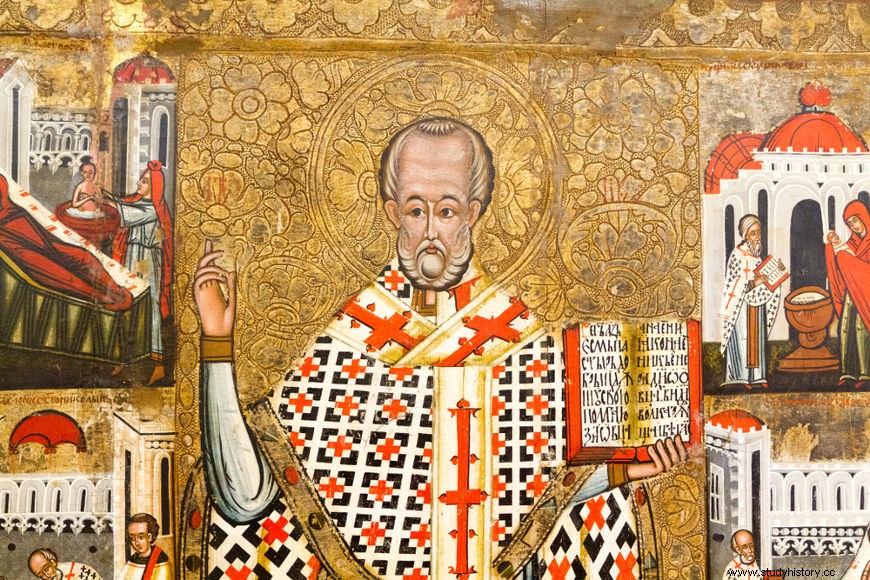The Christmas it is one of the most important moments of Christianity, as it celebrates the birth of Jesus Christ, an event that took place in the year 1, in Bethlehem, in present-day Palestine. We celebrate Christmas on December 25 , although there is no historical proof that Jesus was actually born on that day.
Christmas is a period marked by many traditions that include Christmas decorations, the decoration of the Christmas Tree , the exchange of gifts and the holding of the Christmas Supper. In the religious aspect, the Catholic Church also holds a mass known as Missa do Galo. Despite being a Christian festival, Christmas is also celebrated secularly as a time to emphasize values such as unity and love.
Login also :The Christmas Truce in World War I:Discover this peculiar event!
Was Jesus born on December 25th?

Historians have nothing to prove the date of the birth of Jesus Christ. Therefore, it is not possible to say whether or not he was born on that day. What we do know is that, at the end of the 2nd century, Christmas was not celebrated and Christians did not believe that the birth of Jesus had taken place on December 25th.
An account of the year 200, by Clement of Alexandria, says that Christians at the time debated the birth of Christ and argued that he was born on dates such as April 15th or March 21 , for example. It was in the course of the 3rd or 4th century that December 25 was consolidated as Christmas, and a pagan festival of the Romans may have been related to it.
Historians cannot be sure, but the most accepted theory today is that the emergence of Christmas was a response by the Church to the popularization of a festival in honor of sun Invincible and the Miter , two gods worshiped by the Romans. This festival was created in 274, by the Aurelian Emperor, and was held on December 25th.
As this celebration was quite popular among the Romans, it is believed that the Catholic Church made the day as the date of commemoration of the birth of Christ. It was part of a strategy to weaken paganism and conquer the faithful, showing the population that that day was not celebrated the Invincible Sun or Mitra, but the birth of Jesus.
It is also believed that the starting point for celebrating Christmas on December 25th was a determination of Pope Julius I , in 350. In fact, the first written record about Christmas, as a festival on December 25, dates back to 354, in a calendar produced by Fúrio Dionysius Philocalo .
Christmas Traditions
Currently, the way we celebrate Christmas is very different from the first ways it was celebrated. Our Christmas tradition brings together pagan and Christian traits, in addition to having several elements resulting from the modernization of the planet and the secularization of the party. Here we will briefly comment on some traditions:the Nativity scene, the Rooster Mass, Santa Claus and the Christmas Tree.
Learn more :Easter:discover the origin of the most important festival of the Christian religious calendar
Missa do Galo
It is believed to have appeared in the fifth century , by the work of Pope Sixtus III . Some say that this tradition arose in the second century, but this makes no sense, since in that century the birth of Jesus Christ was not celebrated and it was not even believed that he would have been born on December 25th. The Missa do Galo is basically a mass celebrated in the St Peter's Basilica , in the Vatican, and held on Christmas Eve, starting exactly at midnight on December 25th.
Nativity Scene
The Nativity Scene is that representation, in sculpture, of the birth of Jesus in a manger. This is a very common practice among Christians and was created by St Francis of Assisi, in 1223, during a Christmas sermon in the Italian countryside. It was used by Saint Francis to facilitate the understanding of those who heard his preaching about the birth of Jesus. The practice won the favor of the population, spread across Europe and remains to this day.
Christmas Tree

This is a practice originating in antiquity that made the tree an important part of religious rituals. This current symbol was probably inspired by a celebration of the Old Norse who celebrated the Yule or Jol in the period of the winter solstice (December 21). In this Nordic festival, a pine tree was used as a decoration, being an important symbol of fertility.
For the Norse, the tree called julgran related to an important symbol of the cosmology of that people:the Yggdrasil , a gigantic ash tree that held the Universe in its branches. Historians believe that the practice of decorating trees, carried out in December by the Norse, spread across Europe and was modernized, taking on the current contours.
Here in Brazil, the practice of setting up the Christmas Tree, according to our tradition, must be started on November 30 , the moment when Advent begins in the liturgical calendar of Christianity. The tree must remain assembled until January 6 , known in Christianity as Three Kings Day, when common time begins in the liturgical calendar.
Login also :The different representations of Jesus throughout history
Santa Claus

Santa Claus is a very symbolic figure who performs the gift distribution on Christmas Eve. In the current legend, it is said that this old man dressed in red crosses the skies in a sleigh pulled by eight reindeer and enters the houses through the chimney leaving the gifts, but only for the well-behaved children. Originally, this figure of Christmas culture has roots in Christian traditions and pagan .
Santa's Christian origin dates back to St. Nicholas , Bishop of Myra who lived in the region of present-day Turkey in the 3rd and 4th centuries. He became known for being an extremely generous figure who used his family heritage to distribute gifts and help those in need of money and food. His generosity eventually led to him becoming known as a child friend .
The pagan origin, in turn, can refer to Odin , god present in Norse mythology. At the time of Yule , the Norse believed that this god, disguised as an old man, went from house to house to leave gifts. It was believed that Odin crossed the skies on his eight-legged horse , called Sleipnir .
The Christianization of Northern Europe meant that Odin was replaced by Saint Nicholas as a gift-giver. In the Netherlands, the consolidation of Christianity gave rise to the Sinterklaas , an old man who distributed gifts and sent them directly to São Nicolau. With the migration of the Dutch to North America, the myth arrived in the region that today belongs to the United States and thus the Santa Claus (notice the similarity of the name to Sinterklaas ).
Santa's modern contours emerged with a 19th century poem written by Clement Clarke Moore and advertising pieces produced in the early 20th century.
Image credits
[1] meunierd and Shutterstock
[2] Adam Jan Figel and Shutterstock
